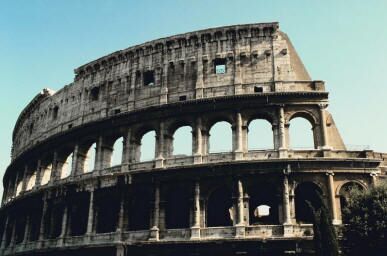Roman entertainment is a byword for the decadence of the late empire, leading to its downfall when it spent more time on amusement than reforming the military or rooting out corruption. But few did mass entertainment better then the Romans. Their coliseums still inspire modern-day sporting arenas. Other forms of Roman entertainment could be found in the amphitheater, the hippodrome or the theatre.
Roman Entertainment: The Amphitheater
The Colosseum in Rome could seat up to 50,000 people and was the largest amphitheatre in the Empire. It was here that people gathered to see the fights between gladiators, slaves, prisoners and wild animals like lions.
The Emperors encouraged people to go to see the fights as it stopped them from being bored and criticising their ruler. The fights were very violent and ended when the loser died.
Sometimes, when the arena was flooded there would be fights with boats. The cells where the animals and prisoners were kept was underneath the floor of the main arena. The Colosseum even had a lift to bring them up to the arena.
Roman Entertainment: The Hippodrome
This was where the Romans went to see the chariot racing.
The Circus Maximus was the largest hippodrome in Rome and could hold up to 250,000 people. Chariots were pulled by 2 – 4 horses, and were driven seven times around the ring at extremely fast speeds. Sometimes accidents happened and drivers were often trampled to death.
There were four teams – red, white, blue and green – and fans of each team would wear their team’s colours.
Roman Entertainment: The Theatre
People went to one of the big theatres in Rome to watch plays.
Because the audience would not stay quiet the actors had to wear costumes. The actors wore masks – brown for men, white for women, smiling or sad depending on the type of play. The costumes showed the audience who the person was – a purple gown for a rich man, a striped toga for a boy, a short cloak for a soldier, a red toga for a poor man, a short tunic for a slave etc.
Women were not allowed act, so their parts were normally played by a man or young boys wearing a white mask.
The actors spoke the lines, but a second actor mimed the gestures to fit the lines, such as feeling a pulse to show a sick person, making the shape of a lyre with fingers to show music. The plays were often violent and could result in the death of an actor by mistake.
This article is part of our larger selection of posts about Ancient Rome. To learn more, click here for our comprehensive guide to Ancient Rome.
Additional Resources About The Romans
Cite This Article
"Roman Entertainment: Bread, Circuses, and Everything Else" History on the Net© 2000-2024, Salem Media.
May 1, 2024 <https://www.historyonthenet.com/roman-entertainment>
More Citation Information.

